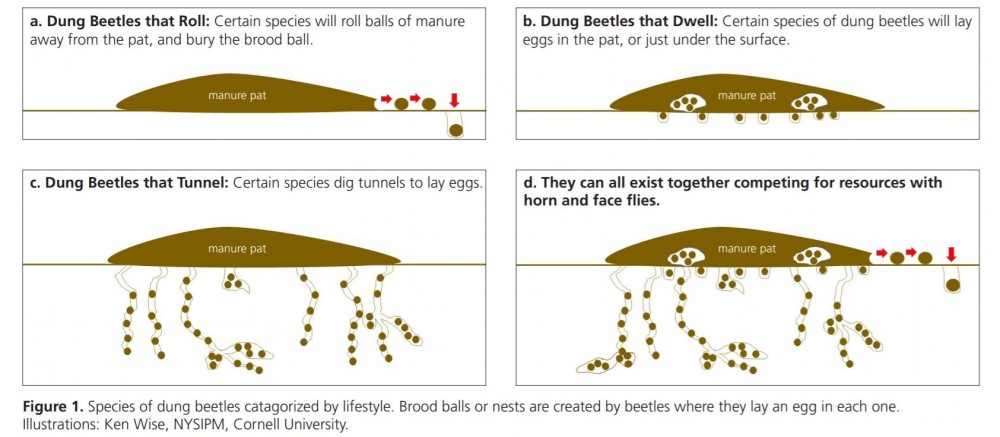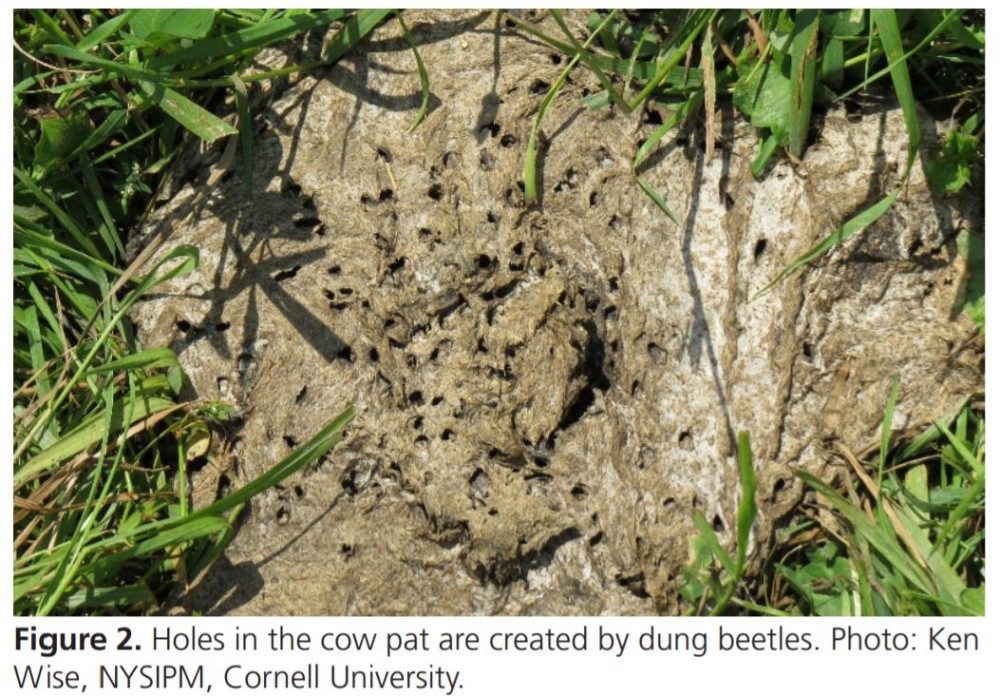Dung Beetles Aid in Reducing Flies and Gastrointestinal Parasites in Pastures
Amy Barkley, Livestock Specialist
Southwest New York Dairy, Livestock and Field Crops Program
Dung Beetles Aid in Reducing Flies and Gastrointestinal Parasites in Pastures
Ken Wise*, Michael Baker^, and Jaime Cummings*
*New York State Integrated Pest Management Program, Cornell University; ^ Department of Animal Science, Cornell University
Dung beetles are important insects for pasture ecology and soil health. They move manure into the soil, thus increasing organic matter, improving soil structure, increasing water infiltration and providing essential nutrients for grass growth. As the majority of cow/calf and stocker operations are pasture based, and with the increased interest in finishing beef on grass, and grass-based dairies, there has been renewed interest surrounding the importance of dung beetles in pasture ecology. There are hundreds of organisms that call a manure pat home. Some organisms are not beneficial, but many of them are. Dung beetles are in the Scarab beetle insect family, and are known for their digging abilities. Dung beetles exist everywhere there is fecal matter. The beetles are attracted by the smell, and can find a new cowpat within seconds. Dung beetle adults can fly, and, depending on the species, they fly at night and/or during the day. An interesting fact is that certain species of dung beetles prefer certain kinds of manure. There are about 90 species of dung beetles in North America.
There are three categories of dung beetles.
Rollers (telecoprids)
Geotrupes species form balls of manure which they push from the pat to bury as brood balls. This group of insects comprise nesting species. The male and female beetles work together to bury the brood ball to feed their young.
Dwellers (endocoprids)
Aphodius species consume the manure as they tunnel within the dung pat and lay eggs directly in the manure or surrounding soil. Most dung beetles found in New York are dwellers.
Tunnelers (paracoprids)
Onthophagus species are tunnelers which consume the pat and burrow beneath it to bury brood balls. This group of nesting dung beetles also relies on male and female beetles to bury the brood ball to feed their young.

Tunnelers and dwellers are very effective at recycling manure back into the soil quickly. Rollers are less effective. However, when they are all working on the same manure pat together, it can disappear within 36 to 48 hours.
Why would this be important? The dung beetles compete with face and horn flies and gastrointestinal parasites for manure in cowpats on pasture. By removing and consuming the manure, they eliminate the flies' and parasites' ability to develop because they compete for resources. Dung beetle activity may be obvious as many holes in the top of a dung pile. Dung beetles create these holes, and you may see the actual beetles scurrying around

De-wormers, such as ivermectin, are very detrimental to dung beetles. The parasiticides will pass through the animal into the dung, thus killing beneficial dung beetles. When conditions are ideal, dung beetles on pasture can control up to 95% of horn flies, if ivermectin is not used. Ivermectin treatments for cattle can last 1-3 weeks in the manure. Safer parasiticides for dung beetles include moxidectin products.
There are feed-through insecticides to control horn and face flies on cattle. These insecticides pass through the cattle and kill the fly maggots in the manure pat. Some conflicting research show that feed-through insect growth regulators (IGR) may or may not damage dung beetles. Dung beetle populations are reduced at varying rates, depending on the concentration of feed through insecticides in the manure.
In some studies, methoprene used at labeled rates did not significantly reduce certain species of dung beetle populations. Whereas, diflubenzuron has shown mixed results but is still assumed that, if used a labeled rates, it will not significantly damage populations. Again, like the previous two insecticides, organophosphate products have mixed results on potential reduction of dung beetle populations.
In this article, we have only addressed the use of de-wormers and feed-through insecticides. There are other forms of insecticides that can be used on cattle. The take home message here is that de-wormers, with the possible exception moxidectin, can reduce dung beetles in a pasture. There are mixed results with the use of feed-through insecticides. We need more research on the effects that feed-through insecticides have on specific species of dung beetles. The complex of dung beetle species is what helps eliminate manure pats in a pasture quickly. The list below are the feed-through insecticides that are registered in New York State.
Many producers who have stopped using feed-through insecticides and de-wormers suggest that horn and face flies, as well as gastrointestinal parasites, were well-controlled in combination with good pasture management. Many people ask how to increase the dung beetles in pastures. One way to tell if you have a good population of beetles is to inspect and monitor a few new cowpats in the pasture. If they are not incorporated or spread-out within two days, you may have a low population. Some of the best management practices for enhancing dung beetles in a pasture are:
• Limit the use of de-wormers to increase the number of dung beetles and other beneficial organisms in a pasture.
• Use short-interval rotational grazing and concentrate the amount of manure in a paddock to increase the number of beetles in an area.
• Use a fecal analysis to determine if parasite eggs are present to decide if de-worming is necessary.
• If animals need to be treated with a de-wormer, keep them in the same paddock until the product residues are gone from the manure. This will limit the dung beetle exposure and reductions to one paddock.
• If treatment is needed, do it in the cooler time of the year when beetle activity is minimal.
• Use action thresholds for fly management. Control them only when necessary. The action threshold for horn flies is an average of 200 per beef animal, 100 per dairy animal; face flies are 10 per face, and stable flies are 10 per four legs.
• If an insecticide is needed, use back-rubbers, dusters, facerubbers and direct animal sprays or dusts because it limits the amount that ends up in the manure.
• When grazing, if possible, do not allow the animals to eat the grass shorter than three inches tall. Parasite larvae can climb up three inches on grasses to enter the animals. This would work well in intensive rotational grazing systems.
Other environmental factors may affect dung beetle populations. Dung beetles need moisture, and when pastures get dry it may affect the populations. Other factors may include soil type, elevation, slope and more.
You can see dung beetles in action in the following videos in English and Spanish:
• Dung Beetles in Pasture youtu.be/9rsDnm9ATcw
• Escarabajos estercoleros en pastos youtu.be/ZKQIMnel70U
Insecticide Feed Additives for Fly Control for Cattle (May 2020)
Methoprene (Insecticide Group 7a-Juvenile Hormone)
ADM Dipteracide Premix 10.5%
Altosid Cattle Custom Blending Premix
Altosid Fly Control 0.4% Premix
Altosid IGR 1% Liquid
Altosid IGR Custom Blend 2%
Altosid IGR Small Pack 0.4%
BOVALYX® Protein Block Containing IGR
BOVALYX® Recharge with IGR
Cargill Cattle Grazers All Season MAG Altosid
Cargill Right Now Emerald (Altosid) MC
CRYSTALYX® IGR PRO
Framework 365 Mineral ADE AFC
Framework 365 Mineral Pasture Breeder Aide AFC
Kent EnergiLass® 12 AFCTM
Kent EnergiLass® Cattle Mineral 8 AFC
Purina Wind and Rain as a 4 Mineral Tub Altosid
Purina Wind and Rain Storm All Season 7.5 CP Altosid
Purina Wind and Rain Storm AS 7 Complete Availa 4 Altosid
Purina Wind and Rain Storm Hi Mag 4 CP Altosid
R-ST 10 Cattle Premix
Southern State Traditions Fly Stop Dairy/Beef Mineral Block W/Altosid
SweetCake Mineral Tub With Altosid Fly Control
Ultralyx 20% Mag Fly Control
Vigortone 3V5 S Altosid IGR
Vigortone 3V5 S Cinnagar Altosid IGR
Diflubenzuron (Insecticide Group 15-Inhibitors of Chitin Biosynthesis)
Clarifly Add Pack (calves only)
Clarifly Concentrate 8% Insecticide
Clarifly Livestock Premix .04%
CRYSTALYX Mineral-Lyx with Clarifly
Elim-A-Fly-Clarifly (Calves Only
JustiFly 0.67% Diflubenzuron Larvicide Premix
JustiFLY Feedthrough
JustiFly Fly-A-Sa
Praire Pride ClariFly Fly Control Block
Sweetlix Clarifly Control Block
Tetrachlorvinphos (Insecticide Group 1b-Organophosphate)
Praire Pride Feeds Rabon Pressed Block
Praire Pride Feeds Quality-Nutrition-Value Rabon Pressed Block
Rabon 7.76% Oral Larvicide Pre-Mix
ROLYX Pro-Mag
Sweetlix EnProAl Rabon Supplement
Sweetlix Pest-A-Side Pressed Block with Rabon
Sweetlix Rabon Molasses Pressed Block
*** For all these products, read the label for proper use ***
For more information, please these references (all websites accessed May 18, 2020):
ATTRA Sustainable Agriculture Program. Dung Beetle Benefits in the Pasture Ecosystem. attra.ncat.org/product/dung-beetlebenefits-in-the-pasture-ecosystem/
Beef Magazine. Beetle Mania. beefmagazine.com/mag/beef_ beetle_mania
Gallagher. Dung Beetles are Small, but Mighty Beneficial Pasture Insects. am.gallagher.com/us/in-practice/dung-beetlesare-small-but-mighty-beneficial-pasture-insects
Kryger, U., et. al. 2007. Effects of Cattle Treatment with a Fluazuron Pour-On, on Survival and Reproduction of the Dung Beetle Species Onthophagus gazella (Fabricius). Veterinary Parasitology 143(3-4):380-4.
Managing Wholes. Dung Beetles and their Effects on Soil. managingwholes.com/dung-beetles.htm/
MN Dept. Natural Resources. Dewormer/Insecticide Best Management Practices For Conservation Grazing on MN Wildlife Management Areas. files.dnr.state.mn.us/natural_ resources/npc/bmp_dewormer.pdf
Niño, Elina L., et. al. 2009. Effects of the Insect Growth Regulator, Methoprene, on Onthophagus taurus (Coleoptera: Scarabaeidae). Environmental Entomology, 38(2):493-498. academic.oup.com/ee/article/38/2/493/527276
PennState Extension. Prevent Parasites Through Grazing Management. extension.psu.edu/prevent-parasites-throughgrazing-management
PennState Extension. Prevent Parasites Through Grazing Management. extension.psu.edu/prevent-parasites-through-grazing-management
Verdu, Jose R., et. Al. 2015. Low Doses of Ivermectin Cause Sensory and Locomotor Disorders in Dung Beetles. Scientific Reports 5(13912).
WA State Univ. Kittitas County Extension. Dung-Beetle Friendly Parasite Control. https://s3.wp.wsu.edu/uploads/...
Wardhaugh, K.G. 2005. Insecticidal Activity of Synthetic Pyrethroids, Organophosphates, Insect Growth Regulators, and Other Livestock Parasiticides: an Australian Perspective. Environ. Toxicol. Chem. 24:789-796.
The original article can be viewed here: https://ecommons.cornell.edu/bitstream/handle/1813/69933/dung-beetles-FS-NYSIPM.pdf?sequence=2&isAllowed=y
Upcoming Events
IPM Strategies to Protect Corn and Soybean Seed in NY
July 30, 2025
Hamburg , NY
SWNYDLFC and Cornell IPM are hosting a grower meeting to discuss integrated pest management strategies for protecting corn and soybean seed in New York.
FAMACHA Training for Sheep and Goat producers in Woodhull NY
August 13, 2025 : FAMACHA Training in Woodhull
Woodhull, NY
Join us for a discussion and hands-on training for internal parasite integrated pest management in sheep and goats. Certification is available to all students participating in the workshop.
Cover Crop & Soil Health Field Day
August 13, 2025
Andover, NY
Please join us for a morning of hands-on learning with expert insights from local farmers, industry representatives, and extension. We will have some demonstration plots in action along with discussion about how cover crops influence soils and demonstration showing impacts on farm resiliency.
Announcements
No announcements at this time.





